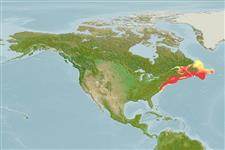Common names from other countries
Environment: milieu / climate zone / depth range / distribution range
Ecologie
; diepteverspreiding 0 - 480 m (Ref. 4), usually 4 - 50 m (Ref. 4). Temperate, preferred 6°C (Ref. 107945); 54°N - 35°N, 78°W - 52°W (Ref. 4)
Northwest Atlantic and Western Atlantic.
Length at first maturity / Size / Gewicht / Leeftijd
Maturity: Lm 8.8, range 7 - 9 cm Max length : 114 cm TL mannelijk/geslacht niet bekend; (Ref. 81053); common length : 25.0 cm TL mannelijk/geslacht niet bekend; (Ref. 4); Maximaal gepubliceerd gewicht: 1.7 kg (Ref. 81053)
Benthic in coastal and shelf waters (Ref. 106894). Possibly a selective feeder, preying mainly on crabs, echinoderms, mussels and polychaetes but also ingesting algae and seaweeds, with a complex foraging behavior and thus capable of maintaining gross diet composition despite of sharp variations in prey availability, seasonality and ontogenetic changes, e.g., molt- and size-related diet shifts (Ref. 33024). Migration does not occur, or only to a limited scale (Ref. 4).
Life cycle and mating behavior
Geslachtsrijpheid | Voortplanting | Kuitschieten | Eieren | Fecundity | Larven
The females carry their eggs for 10 to 11 months, ovigerous females are found throughout the year (Ref. 4). 0.5 broods per year (Ref. 81148); 0.15 cm postlarval size (Ref. 81158); 1 month pelagic period (Ref. 81159).
Holthuis, L.B. 1991. (Ref. 4)
Status op de Rode Lijst van het IUCN (Ref. 130435)
Status bij CITES (Ref. 108899)
Not Evaluated
Not Evaluated
Gebruik door de mens
Visserij: van groot commercieel belang
FAO - Visserij: landings, soortsprofiel | FishSource | Sea Around Us
Tools
Internet-bronnen
Estimates based on models
Preferred temperature
(Ref.
115969): 2.7 - 15.4, mean 10.2 (based on 112 cells).
Weerstandsvermogen
laag, minimale populatieverdubbelingstijd 4,5-14 jaar (K=0.07-0.09; tm=5).
Prior r = 0.47, 95% CL = 0.31 - 0.71, Based on 2 full stock assessments.
Kwetsbaarheid
Moderate to high vulnerability (46 of 100).
